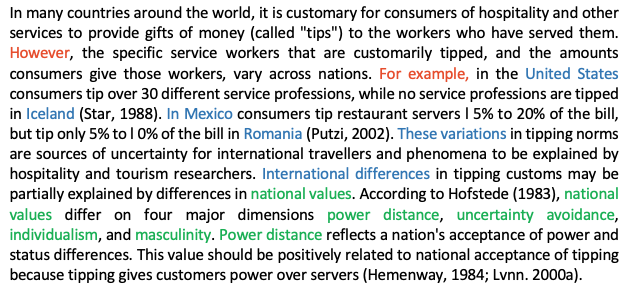Academic Writing Style
Academic writing should remain objective, clear, precise, responsible, and well structured. Here you can find a few ways to achieve this.
Passive and active voice
The passive voice is often used to describe processes as it places the focus on the action rather than the person doing the action and it is less personal. However, academic writing aims to describe processes in a clear, precise, and responsible manner. By using the active voice to discuss previous research and your own method, you can achieve all three of these goals. First, the active voice generally provides more clarity. Second, it is shorter and more precise as it does not conceal the identity of the action taker. Third, it is responsible as it clearly gives credit to the researcher in focus.
- Passive: Research on the effectiveness of transformational leadership in various cultures has been conducted.
- Active: Budur (2020) investigated transformational leadership in various cultures.
Further information can be found on APAStyle.
Use of pronouns
When referring to your method, you may use the pronoun I to describe the steps taken in your research. Using the pronoun I does not automatically lead to subjectivity. The method you follow must be based on theory and previous research addressed in your literature review. The theory and previous research should be critically assessed, leading to an objective method selection. Using I allows you to write your method section with more clarity and precision.
For more on the use of I, we, and the author, refer to apastyle.apa.org.
The use of the second person pronoun you should be avoided. A certain distance should be kept between you (the author) and the reader. You also should avoid making assumptions about the readers’ interpretations, understanding, or stance.
Gender-inclusive language
In general, academic papers must be written using gender-inclusive language. The so-called legal definition: “For simplicity, only the male form is used in this text. The female form is of course always included.” is considered outdated, inappropriate, and is not accepted at the School of Business.
To avoid sexist language (e.g., using he or she for a generic person), opt for the plural form, gender-neutral wording, or they. For instance, e.g., students instead of student or female student or spokesperson instead of spokesman or spokeswoman. More examples of they can be found here.
See also: FHNW Sprachkompass
Bias-free writing
Bias in writing extends far beyond the use of gendered pronouns. Academic writing should be precise and avoid generalizations about groups of people. APA Style provides a list of guidelines on how to avoid bias in language.
Tenses used in academic papers
| Paper section | Recommended tense | Example |
| Literature review (or whenever discussing other researchers’ work) | Past | Martin (2020) addressed |
| Present perfect | Researchers have studied | |
| Method Description of procedure | Past | Participants took a survey |
| Present perfect | Others (e.g. Smith, 2018) have used similar approaches | |
| Reporting of your own or other researchers’ results | Past | Results showed Scores decreased Hypotheses were not supported |
| Discussion of implications of results or of previous statements | Present | The results indicate The findings mean that |
| Presentation of conclusions, limitations, future directions, and so forth | Present | We conclude Limitations of the study are Future research should explore |
Text flow
Paragraphing
The following paragraph from Swales and Feak (2015, p. 30) provides an excellent example of paragraphing and text flow.
- It starts with a general topic sentence and provides several supporting sentences which expand on the topic and draw conclusions.
- It includes linking words: however, for example
- It uses a variety of phrases to refer back to early mentioned information: these variations, international differences
- Ideas build on each other
- Mini-summary sentences are used to link information make a point:
- Linking: These variations in tipping norms are sources of uncertainty for international travelers and phenomena to be explained by hospitality and tourism researchers.
- Mini conclusion: This value should be positively related to national acceptance of tipping because tipping gives customers power over servers (Hemenway, 1984; Lvnn. 2000a

Connecting sections
Sections in a paper should be well linked despite beginning a new part of the paper. For example, your literature review and method section should be well linked in that your chosen method should be informed by and influenced by the previous research you review. Moreover, the analysis/findings section should be guided and structured by the method section. Including one or more sentences that link the sections in your paper will create a strong through-line.
- In order to fill the research gap mentioned above and answer the set research question, I will…
- In order to establish/determine/further test…
References
APA Style. (2019). Style and Grammar Guidelines. APA Style. https://apastyle.apa.org/style-grammar-guidelines/bias-free-language/general-principles
Swales, J. M., & Feak, C. B. (2015). Academic Writing for Graduate Students (3rd ed.). The University of Michigan Press.